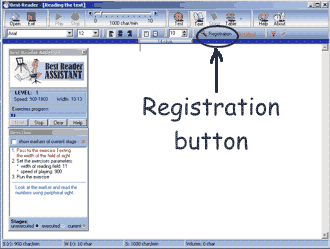

In most cases you start, as Evelyn Wood used to, with an assessment of your current (bad) reading habits. With this technology I found I could just about read simple passages for sense at 700wpm, an ability I imagine would become more natural, if not necessarily more comfortable, the longer you practised it.īoth of the apps – and there are dozens of others to choose from – come with tutorials and exercises to help you “master” the system. Spritz – which drives the app ReadMe! – offers successive individual words in which one letter, just before the midpoint of each word, is highlighted in red, keeping your focus on that precise point on the screen (the “Optimum Recognition Point”). Spritz technology, meanwhile, developed by a company in Boston, is based on the idea that much of the time “wasted” in reading is spent in the fractions of seconds as the eye’s focus moves between words and across the page. I found that I could just about take in three-word chunks of Animal Farm for sense at 800wpm, but that in doing so I not only had a slight feeling of panic in trying to keep up, I lost any sense of the rhythm of language, and with it any of the tone of what was being said. The Spreeder app allows you to choose the number of words you see at each moment, and to vary the rate at which these words come at you. Two of the more popular platforms offer a slightly different approach. The rate at which they do so can be set to 300 or 500 or 1,000 words a minute, enabling you to feed in text and books to be “read” faster and faster.
Best speed reading software serial#
The apps generally use a technology called Rapid Serial Visual Presentation (RSVP), in which individual words, or blocks of two or three words, appear one after the other in the centre of your screen. For the past couple of weeks I’ve been experimenting with a few of the best known, mostly on my smartphone.

These twin perceptions have led to a wave of businesses and apps that once again aim to “revolutionise your reading speed” (at the cost of $4.99, or whatever, a month). The second factor is the belief that since text can now be presented more dynamically on screens we are not “restricted” by the rigidity of printed sentences on a page: surely there is a better way? With Rapid Serial Visual Presentation, individual words, or blocks of two or three, appear one after the other on screen The first is the persuasive perception that we are living in times of information overload, that we are daily presented with more words than we can possibly cope with, and that new tactics are called for to enable us to make sense of it all. Recently, the attractions of speed reading have been revived and promoted, for a couple of reasons.

The science of Wood’s method was never remotely proven, however, and by the time of her death in 1995, her ideas had fallen out of fashion. Presidents Nixon and Carter, under mountains of briefings, followed suit. President Kennedy, who believed himself to be a gifted speed reader (and who colleagues observed “reading” the New York Times and the Washington Post each morning in 10 minutes flat, scanning and turning the pages), sent a dozen of his staff to the Evelyn Wood Reading Dynamics Institute in Washington. By the end of a course in Reading Dynamics, breathless students were “reading” Orwell’s Animal Farm at the rate of 1,400 words a minute, and telling tales of revolution. To achieve this, Wood promoted a technique of running a finger down the middle of a page to “activate peripheral vision”. Print should be consumed in blocks rather than words and sentences. We had to stop “subvocalising” – “saying” words out loud in our heads as our eyes moved across the page – as well as learning to outlaw the pauses and detours that led to us reread phrases when our minds drifted or our understanding snagged. The way in which we read, she professed, in the managerial spirit of the moment, was inefficient in terms of time and motion. With Doug, her husband, Wood opened her Reading Dynamics institutes across the US and beyond in the 1950s and 60s, and her methods became a self-help craze.


 0 kommentar(er)
0 kommentar(er)
